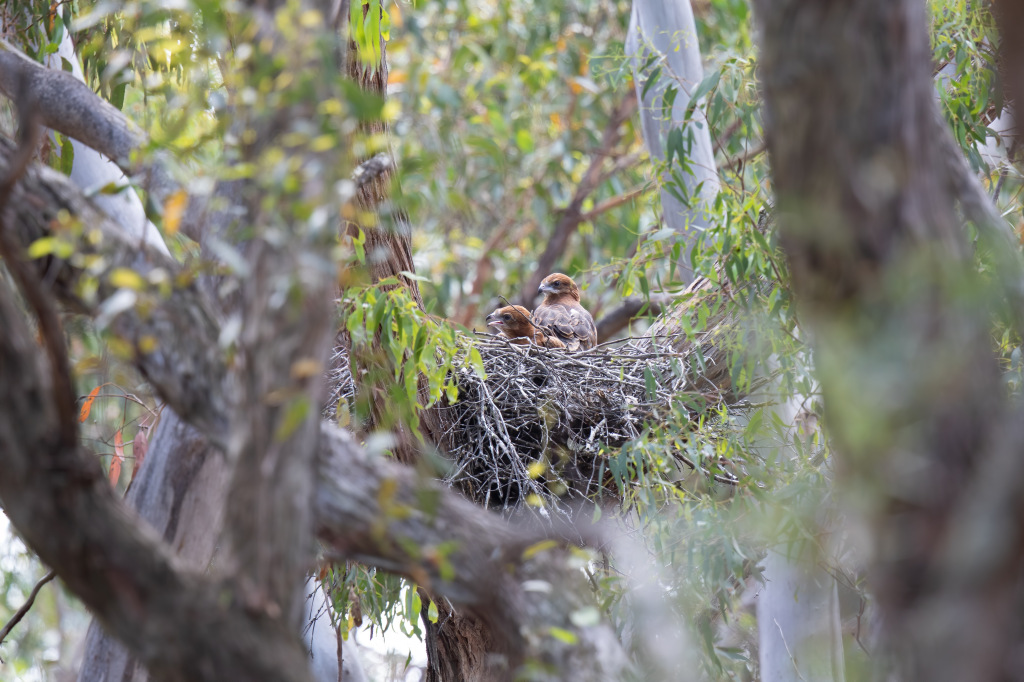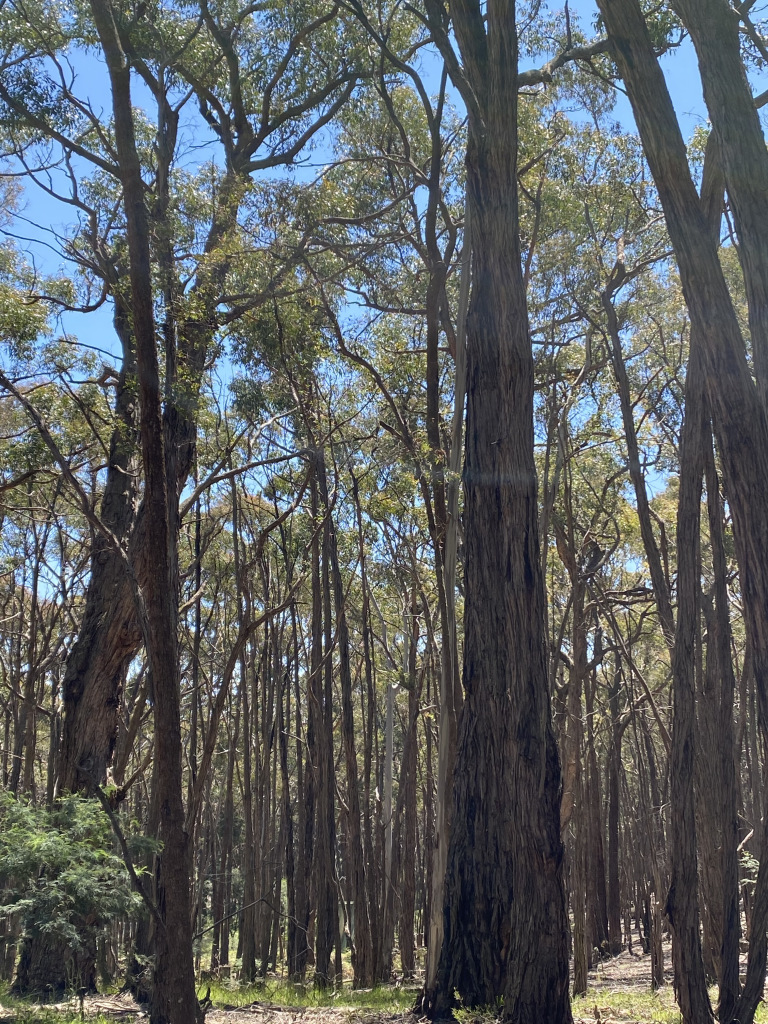One of the very best things about 2020 was the return of Square-tailed Kites nesting in my local area! Friend and brilliant photographer Ambika Bone came out in December with Kaz, an old mate, to photograph the gorgeous rufous coloured fledgelings. We stayed on the road to observe the nest, so Ambika sent through the pics with the provisio that they are “very far away” but I LOVE THEM! As I peered at the nest day after day through excellent but not very powerful binoculars, the photos are a wonderfully accurate representation of how I enjoyed mum and the two chicks.

I wrote an article for the Wombat Forestcare newsletter – front page! To see the whole newsletter click here – or read on – I have reproduced it in full below…
This summer, a pair of Square-tailed Kites Lophoictinia isura nested in my local area for the first time since 2003. In these turbulent times, it has been a joy and a source of comfort to walk down to see the nest and gaze at the family, with binoculars, recording their daily behaviours and watching the two young transform from fluffy white chicks to sleek juveniles.
The Square-tailed Kite is one of our few birds of prey that are endemic to Australia, that is, found nowhere else in the world, and has been evolving in Australia for a very long time. Our other closely related endemic raptors include the Black-breasted Buzzard, of inland and northern Australia, and the Red Goshawk, which is our rarest bird of prey species.
Individuals have very long upswept wings. In flight they soar and sail effortlessly, with a very high wing loading similar to a Swamp Harrier. Seen from below, the wings are “stripy” or barred with distinctive pale “windows” or spots unlike any other raptors. When perched, these long wings are actually longer than the tail, another diagnostic feature. Adult Square-tailed Kites have the most amazing white face with yellow eyes; they really remind me of a nice domestic chook! The young bird is a rich rufous colour, with a round fluffy head and a small fine beak and brown eyes.

Many birds of prey, such as Wedge-tailed Eagles or Brown Falcons will take a variety of prey items, from rabbits to insects to pigeons to carrion, such as road kill; the Square-tailed Kite is a specialised predator of nestling birds. They hunt slowly and efficiently, flying backwards and forwards, soaring and scanning the tree canopy nests (this is known as quartering), then simply flying down and using their long legs and hooked talons to remove the baby bird or birds. The kites also eat insects. Not much is known about what kites eat in their non-breeding season.
The Square-tailed Kite is a spring-summer migrant to southern Australia, and is mostly absent from the tropics in the wet season. It is a summer breeding visitor to the Wombat forest region. In order to feed themselves, and their one to three young, we can assume that the kites will choose a nest site where there is a high diversity of birds, and also abundant populations of these birds.
It is wonderful to think that our local kites may have overwintered as far away as the Kimberley ranges in Western Australia, and then flown all the way to these foothill forests to breed.
A look at Birdata shows that most records for the species occur around Castlemaine, Daylesford and Creswick area, rather than in the deep forests of the Wombat, although a pair of Square-tailed Kites nested in the Blackwood forest near the Garden of St Erth, in the early 2000s.
The first nest site I observed here in Porcupine Ridge was back in 2003, with two healthy nestlings fledged. This nest was on public land, in grassy dry forest. Sadly, the pair did not use the nest the following year, or appear to nest again locally. However, they have been recorded using the area in the summer months over the years. In 2005-2007 my records show I often saw a Square-tailed Kite on summer evenings, between 5 and 8pm, either hunting or sitting on a favourite roost tree, its white face pointed towards the prevailing breezes. I was very relieved when I saw the mate.
Square-tailed Kites are monogamous and have high nest fidelity, so you can have a situation with one partner returning alone and not nesting, sometimes for years!
I discovered the 2019-2020 nest thanks to my friend and neighbour Paula Roozenburg. Paula texted with the news – we went for a short walk, and there it was! A Square-tailed Kite nest, in the forked branches of a messmate, in thick regrowth forest on private land. The nest was visible from the road, and if you moved even slightly you lost sight of it, so I felt confident that the nest would be free from any disturbance. Paula only noticed the nest as she was lucky enough to witness one of the adult kites repeatedly flying at and trying to drive away a raven from the nest area.
My first nest observation was on 2nd November. I then walked past the nest nearly every day until mid-January, with binoculars in hand and the Birdata app on my phone. What a privilege! The first four weeks were characterised by a very resolute female brooding at the nest, through high wind, heavy rainfall and hot weather. I observed another adult bringing food to the brooding female, presumably the male with a small passerine bird of some kind, very likely a honeyeater. The food exchange was accompanied by thin, repeated screams from both sexes.

Then on 30th November, I changed the angle at which I observed the nest and two very white fluffy chicks were seen, and they were surprisingly large! I expect that the chicks were not visible when they were very tiny. By 5th December the young had started to develop rufous coloured feathers among the white down, with one chick clearly larger and more developed than the other. I was lucky to observe the mother kite breaking off tiny morsels of a dead bird to feed to both chicks, a typical example of their solicitous and careful parenting. The father’s role involved a carefully executed flyby, manoeuvring those magnificent wings and then simply wafting down to drop prey into the nest and keep on flying.
By mid-December both chicks were fully feathered in this rich and simply gorgeous rufous colour (see Ambika’s lovely photo). During this period the chicks could be seen perching on the edge of the nest, gazing at the sky and the canopy with much interest. Mum was increasingly away.
On 25th December, I could see the larger nestling pulling large fragments off an unidentified prey item in the nest. Both nestlings were standing tall and perched high near the nest edge. Then the younger nestling started eating as well, pulling on a portion of prey, further along from the older nestling. The older nestling looked on and wiped its beak on the nest edge. There was very little conflict observed, and many of the accounts I have read of this species emphasise the gentle, confiding nature of both adults and chicks.
On 1st January, I observed the next stage in the development of the young birds; the practice known as branching, when the chicks have not yet fledged but spend time perching away from the nest, returning to feed or rest. Branching allows them to practice perching on different surfaces, clambering in trees, and undertaking short flights while still in the protected area of the nest site.
Branching can go on for weeks, as well as post-fledging parental care such as feeding. I anticipated observing the young and parents in the area for some time during January and early February, but after a period of seeing either some or none of the family, I saw both young back in the nest on 20th January. Then, after that there were no more sightings! Perhaps the family found another area suitable for post-fledgeling care.
Like the Little Eagle reported in this newsletter, the Square-tailed Kite is a very important species in the Wombat forest.
The Square-tailed Kite is classified as widespread, but rare, and has suffered declines as a result of land clearing for agriculture and development, and degradation of habitat as a result of prescribed burning and logging. The Victorian population is estimated at between 20 and 50 pairs, although it is seen more frequently in western Victoria in recent years (Tzaros C, 2020, Garnett & Crowley 2000). The conservation status of the Square-tailed Kite was recently re-assessed from Vulnerable in 2013 (DSE 2013) to Critically Endangered in 2020 as part of the Victoria Government’s Conservation Status Assessment Project (DELWP 2020). Critically Endangered!!
This is interesting given the recent anecdotal reports of an increasing population in western Victoria, but this may be a case of better conditions in Victoria compared to SA, NSW and Queensland. As a top order predator, these birds need a healthy forest, with a full suite of insect life and eucalypt flowering to support the honeyeaters and other small birds that support the kites.
References
Marchant, S. & Higgins, P.J. (Eds) (1993). Handbook of Australian, New Zealand & Antarctic Birds, Volume 2: Raptors to Lapwings. Oxford University Press, Melbourne.
https://www.environment.vic.gov.au/conserving-threatened-species/threatened-list
Resources
Such delights -Square-tailed Kites! A wonderful blog post with writing, images and video about a pair of kites in Clunes.
Video footage of an adult soaring low through the canopy, and adults and chicks at nest, by “filming wildlife”.

Fantastic story and photos Tanya…this is a case of ‘go find a Kite’ instead of ‘go fly a kite’. I’m also seeing more pairs of S-t Ks hawking in Central Vic! Good news!
Thanks Sue! It was such a pleasure to watch the kites every day. And how good to have a good news story for once eh! See you out in the bush soon I hope, Tanya